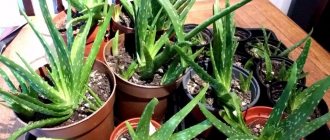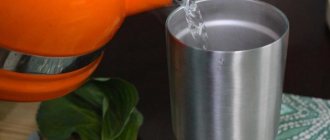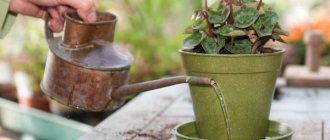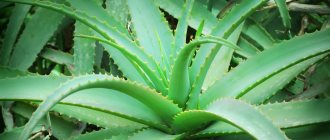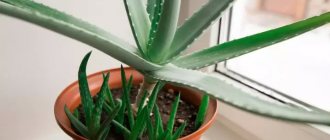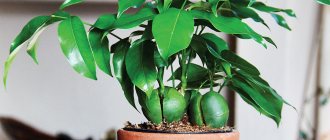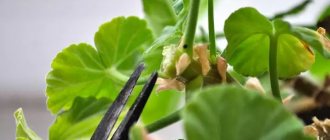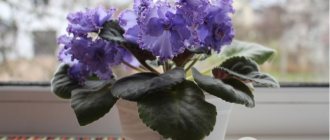What kind of pot is needed for Aloe
Aloe is a good medicine that is convenient to grow at home. Can help with cuts and chronic diseases. What is the convenience of keeping a plant at home? The fact is that aloe is easy to care for and does not need abundant watering. In winter no more than once a month, in summer a little more often.
Main characteristics and description of the plant
The first mention of this plant is found on cuneiform tablets of the Sumerians, the date of production of which is more than 2000 BC. e. This plant is also depicted on the walls of some temples located in Ancient Egypt, which are also thousands of years old.
The appearance of this healing perennial and its biological characteristics indicate that aloe was born in hot and dry climatic conditions and only after many years began to spread to other continents. Under natural conditions, aloe can be found in all countries located on the Arabian Peninsula, Madagascar, the Canary Islands, as well as in a number of North African countries.
The Aloe Vera variety is the most popular and useful perennial of all species, it has various healing properties, therefore in many countries it is grown on an industrial scale, there are many factories for processing this raw material - in words, growing and processing Aloe Vera is a profitable business.
Which pot is suitable for aloe
It is recommended to plant and replant the plant in the spring, since the aloe has already faded. The first transplant is carried out after a year, subsequently the period increases to once every 2-3 years. Aloe Vera has a fibrous root system. The root shoots resemble a cone shape - the roots are long cylindrical in shape.
The plant collects moisture at the tips of its roots, which means it needs to be watered not in a pot, but closer to the roots - in a tray. It is necessary to take into account these features so as not to make a mistake and the aloe does not die.
Features of choice
In stores you can find pots made of plastic or clay. There is no right choice of material.
Therefore, it is worth talking about the pros and cons of the proposed options. Plastic: lightweight and cheap pots that do not break if dropped, but often crack if handled carelessly. It is easy to make additional holes if the existing ones are not enough for the flower to exist comfortably.
Clay: the walls of such a container have a porous structure and do not contribute to the stagnation of moisture (therefore, the flower will need to be watered more often); the walls also withstand the attack of hot sunlight and protect aloe roots from high temperatures. Durable in use, unlike its plastic competitor.
You should not plant the flower in a large container, as this promotes the formation of alkali. If you allow a high concentration in the soil, the roots will begin to rot.
Important! There should be 1-2 cm of free space between the roots, walls of the pot and its bottom.
It is worth paying attention to the crown of the flower. The size of the container should be 2 times smaller than the diameter of the plant (the gap between the opposite aloe leaves).
Let's summarize. When choosing a pot, you must comply with the following conditions: 1. The presence of drainage holes at the bottom. 2. When replanting a plant, pay attention to the previous container: the volume should increase by at least 3 cm. 3. If the root system is wide, then you will need a pot with a much larger diameter. 4. If the roots grow deeper, then a higher pot is needed.
Source
Main reasons for changing the potty
Reasons for replanting a succulent:
- Many young shoots have formed that interfere with each other and the mother plant too. Planting is done by dividing the bush into separate independent shoots with good roots.
- If water is quickly absorbed into the soil, then the root system is distributed throughout the flowerpot and instantly absorbs the liquid. It's time to transplant the plant into a spacious flower pot.
- There is a noticeable tightness for the roots of the succulent, which has filled the entire space, that there is no access to the soil along the edge of the growing container and it is difficult to water the plant.
- A flower purchased in a store requires planting in a permanent place in prepared soil intended for succulent plants. The purchased pot contains soil mixture for transportation and is temporary. Contains pieces of foam plastic, broken brick, and shell rock as drainage material.
- Gradually, the soil is depleted due to an excess of salts, and the succulent slows down its growth, the lower leaves deteriorate and dry out. It is necessary to update the soil mixture and transplant the plant into another pot.
- Sometimes a transplant saves aloe from disease or decay. New soil gives the flower additional strength to recover. The paleness of the leaves or blackening from waterlogging of the roots is the reason for moving to another flowerpot and replacing the soil with a new one.
- The agave has aged and requires updating. Curved trunk, asymmetrical formation of the bush, unaesthetic appearance.
- Damage to succulent leaves by fungi, scale insects or spider mites. Separating intact young shoots and treating each plant individually can save aloe from complete infection and death.
A young plant is replanted annually; after reaching the age of 3–5 years, you can do it once every three years. Aloe does not like excess moisture, so it is necessary to arrange drainage from expanded clay and smooth river pebbles.
When the soil is compacted, the growth rate slows down, and a lack of air in the root system leads to yellowing or paleness of the flower leaves. The procedure of replanting an overgrown succulent is stressful for the mother plant, so it is left in a pot if possible, only the young shoots are separated, making room for the root system of the aloe tree. The soil mixture should be updated.
The correct selection of pot size affects the further development of succulent inflorescences. When replanting a plant, the roots should not reach the side walls of the flowerpot by a couple of centimeters, and the volume of the pot should be smaller relative to the size of the crown of the bush.
Simple rules of care allow it to be grown by inexperienced amateurs who have purchased a medicinal plant for the home for the first time.
How to plant aloe at home? Rules for transplanting aloe
It is unknown how and when this plant came to our region, who and for what purpose placed it on their window, or rather, in the winter garden. Perhaps history has preserved such information, but few people are interested in it, and the strange-looking plant took root, settled on the kitchen window and became part of our everyday life, some call it aloe, and others call it agave.
Tree aloe or aloe vera is grown much more often than other species, of which there are more than 300. Unpretentious, like any succulent, it is ready for the most incredible tests and its survival rate is simply fantastic.
What if the plant doesn't take root?
There are several reasons why a plant planted for rooting may not take root:
- the use of low-quality planting material - the material is cut from a diseased or weakened plant. In this case, the flower will have to be thrown away, and only healthy, strong and fleshy parts should be selected for rooting;
- using low-quality soil mixture - if you are not sure of the quality of the self-prepared substrate, it is better to purchase a special one (for succulent plants) and replant the aloe; such manipulation should help rapid rooting;
- organizing improper care - failure to follow recommendations for caring for an unrooted plant often leads to the death of planting material. If the plant dies, you will have to re-select a high-quality young leaf and plant it, observing regular watering and maintaining the required temperature in the room during the growing process.
Planting material
We are used to buying houseplants we like in a specialized store already in a pot, often already mature and flowering, but we most often find aloe from friends and relatives, in a casual conversation over a cup of tea, we learn a lot of interesting things about the properties of the plant, about who from friends and what exactly was cured with this plant - and we take a piece or baby from the mother plant.
Baby
The easiest way to plant is a young plant, of which there are many growing from the mother bush at its very base. The young aloe is fully formed and its root system is ready for independent life, but is located on the surface of the soil, as if waiting to be transplanted into its own pot. Small plants are called babies, and planting them is the easiest and most reliable option.
Upper part of the stem
The part of the stem that is well suited for propagation is the apex, with two or three pairs of leaves. She should have a strong, healthy appearance. There is no need to plant it right away; let it sit for 5 or 6 days, heal its wounds on its own, and the damaged areas should dry out. However, you can also dip the cuttings in water until roots form. There is information about possible rotting instead of root formation, but in my many years of practice this has not happened, the roots sprouted, the young plants lived in ordinary water for about six months, were transplanted into pots and took root normally
Didn't manage to get hold of a baby or cuttings? It doesn’t matter, a leaf is enough, you need to pick it as close to the mother plant as possible, the smaller the tearing area, the faster the leaf will let go of its roots. There is no need to rush with planting; let it sit for a week, heal the wound, and prepare for planting.
Seeds
This method of propagating aloe is also possible, but it is usually used by succulent collectors to grow decorative, variegated species. You will learn all the details about the propagation and cultivation of aloe here.
Which pot should you choose?
Ceramic pot
The best for any plant is a simple ceramic pot.
The clay from which it is made is a natural material, such a pot allows the root system to breathe, regulates soil moisture well, looks decent in any interior, and lasts a long time without losing its appearance. And their range is varied, from simple to elegant and very elegant, but all this is secondary, their environmental friendliness comes first.
Plastic pot A plastic pot
has become a worthy replacement for a ceramic pot; flowers grow in it, and the price is much lower. Children's plastic buckets are a thing of the past; they have been replaced by a wide variety of plastic flower containers in shape, color and size. And for lovers of the classics, of course, pots and pots in the color of ceramics, but made of plastic, are suitable.
However, plastic pots have some disadvantages: they do not allow air and moisture to pass through, the soil needs to be loosened, drainage is especially important and the amount at the bottom of the pot should be at least one quarter of the volume.
Basic recommendations
For aloe, use a shallow plastic pot. It is also possible to use heavy terracotta dishes. These containers, as a rule, do not have pores. Moisture will not evaporate through the walls of such pots, as usually happens when using earthenware. It is necessary to choose a container according to the size of the flower. Its roots should fit easily into the pot (usually about 3 cm remains to the walls).
While maintaining aloe, you need to replant it regularly (about once a year). In this case, not only the pot is usually replaced, but also the soil. It is worth knowing that the soil should be loose and airy. It is advisable to take into account that the plant feels very bad in clay and black soil.
The earth must contain components in the form:
- River, coarse-grained sand.
- Gravel.
- Brick chips.
- Shell rock.
- Perlite.
Today, ready-made mixtures for aloe can be purchased at a specialty store. Usually, land is purchased for cacti. If necessary, add coarse river sand to it. If a person is going to prepare the soil for aloe on his own, then he should take the following components in equal parts:
- clay;
- washed sand;
- humus.
Drainage must be placed at the bottom of the container (broken bricks and small crushed stone can be used). It must be remembered that the holes in the dishes must remain open. Thus, excess water will be drained.
How to plant without roots?
All plants, without exception, need care, attention and love, each of your pets has their own preferences, aloe needs care no less than others. If everything in his life is good, he will delight you with flowers; at first glance, they are modest, but they appear completely unexpectedly at the end of winter, and the color scheme of these small bells is so harmonious that it is impossible not to admire them. You can read about aloe flowering in this article.
The plant does not need frequent watering , you need to water it no more than once every 2 weeks. You can replace watering with spraying, the main thing is not to forget to loosen after watering.
How to replant at home?
The plant is actively growing, is the pot becoming too crowded?
Buy a container that is freer; there should be three or five centimeters of open ground left from its edge to the lower leaves; replanting is carried out according to the same rules as planting. Both autumn and winter are suitable for planting and replanting. Agave or aloe - like a symbol of home comfort and well-being, lives in every home, with very rare exceptions. And even though it itself cannot live for a whole century, everyone has known its healing qualities for a long time. Maybe it was the desire to live 100 years thanks to this healing plant that gave it the name by which it is known among the people.
See more photos of aloe:
How to plant aloe correctly at home
This plant belongs to the category of succulents. Therefore, aloe prefers well-lit window sills and easily tolerates a lack of moisture, as it accumulates it in its leaves with rare watering. If the basic requirements of the culture are met, this plant will not cause any trouble.
Aloe is rightfully considered a home healer.
Note! For its full development, it is important to plant correctly. This procedure includes several main steps. Therefore, it is worth familiarizing yourself with them in advance.
What time of year is it better to plant and is it possible in winter?
It is best to plant aloe, like other indoor plants, in late February - early March. It is during this period that the plant emerges from the state of winter dormancy and biological processes intensify.
If it was not possible to plant during this period, then you can postpone the procedure until the end of summer, namely until July-August. At this time, sap flow in the tissues of the plant increases, so it easily tolerates planting and quickly recovers
Important! Planting aloe in late autumn, as well as at the beginning and middle of winter, is not recommended, since at this time the plant is in the dormant stage and will not be able to fully take root, which means it will die.
What kind of soil is needed for aloe
In nature, this plant can be found in countries with arid climates and soil poor in nutrients. At the same time, aloe feels great in such conditions and grows well. Therefore, it is necessary to prepare soil for it, the composition of which will be as close as possible to its natural habitat.
You can purchase a ready-made substrate at a flower shop, choosing a soil mixture for cacti and succulents. But you can also prepare suitable soil for aloe yourself. The main thing is that the substrate is loose, light and well-drained.
To plant aloe you will need to mix the following components:
Important! Peat should not be added to the soil, as it increases acidity, and this has a depressing effect on the roots of the plant.
The soil for aloe should not be nutritious, the main thing is that moisture does not stagnate in it.
In what container is aloe grown: pot sizes
The root system of aloe, like all succulents, is small, but the leaves are fleshy and large, since they contain a supply of moisture and nutrients. Therefore, it is necessary to select not too deep, but wide pots for the plant. When planted in high containers, the plant will constantly turn over.
The diameter of the pot should be selected depending on the age of the seedling
At the initial stage of growth, the width of the planting container should be within 8-9 cm. With subsequent transplants, it can be increased by 2-3 cm.
For your information! You cannot immediately plant aloe in a container that is too large, as the excess soil in the pot will begin to turn sour and cause root rot.
When is aloe capable of blooming?
The plant is a succulent, unpretentious to living conditions, and tolerates long-term drought. You can safely leave it for 2-3 weeks without care when going on vacation.
Under natural conditions, aloe is exposed to significant temperature changes and experiences periods of dormancy and increased activity. It is these changes that the pampered indoor plant lacks.
Most often, a flower pot with a succulent is placed in a room where a comfortable temperature is maintained within 22-25 degrees, and it is watered along with the rest of the plants. In such conditions, flowering cannot be expected.
To awaken the craving for the formation of a peduncle, it is necessary to artificially create a dormant period for aloe, after which a new life cycle will begin. The winter months are best for this.
To bloom, aloe must be over 5 years old. And ideally, you need to have a plant that has already passed the ten-year mark. In the first 3 years of a succulent’s life, active formation of leaves and roots occurs, so it is impossible to achieve either medicinal properties or flowers from aloe at this time.
How to properly plant aloe in a pot
Before you start planting, you need to prepare everything in advance so that everything is at hand during the procedure. For this you will need:
When everything is prepared, you can proceed directly to planting aloe. It is important to follow the procedure and strictly adhere to the recommendations.
Note! When planting, the aloe root collar should be at or slightly above the soil surface, which will eliminate the possibility of stem rotting.
As soon as the seedling begins to grow, it must be placed on a sunny windowsill. In the future, it is necessary to water the planted plant as the top layer of soil dries out.
How to grow aloe from a shoot without roots
Sometimes the question arises of how to plant aloe if the shoot is without a root. It is quite possible to grow a plant in this case if you act correctly.
This situation may arise in the following cases:
Important! Since aloe is a succulent, it is not recommended to root the shoot in water, as it can rot, so it is better to plant it directly in the soil.
Are there any chances of success?
Before planting a cutting without roots, it is necessary to refresh the cut and leave it to dry for 2-3 days in a shaded place. During this time, a kind of film is formed that protects against infection from penetrating the plant tissue and prevents excessive evaporation of moisture.
Rooting of the shoot occurs within 3-4 weeks
In the meantime, it is necessary to prepare special soil for the aloe shoot. In this case, you need to mix turf soil and river sand in a ratio of 1:2. Heat it in the oven for 15 minutes. at a temperature of 100 °C to disinfect.
To plant the shoot, you can use a plastic glass, make drainage holes in it, lay expanded clay on the bottom in a layer of 2 cm, and fill the remaining 2/3 of the volume with the prepared substrate and moisten it. After this, plant the shoot, deepening it into the soil until the first pair of leaves. Then compact the soil at the base and sprinkle the surface with small pebbles. This will strengthen the seedling and prevent it from falling.
For complete rooting, it is necessary to move the container with the cuttings to a bright place with a temperature of 23-25 ° C, and the plant should not be exposed to direct sunlight. Periodically it is necessary to moisten the soil, observing the rule - it is better to underwater than to overwater.
If the entire procedure was carried out correctly, the shoot will take root without any problems. This can be determined by the new leaves that begin to appear at the top.
For your information! A month after rooting, the shoot must be transplanted into suitable soil and pot.
From seeds
It is advisable to plant seeds in late February - early March. It is necessary to prepare the soil, pour it into a flat small container. The seeds are laid out on moistened soil and then sprinkled with sand. Agave should be planted to a depth of about 1 cm.
The container with seeds must be installed in the greenhouse
It is important that the temperature is +21 degrees. When growing aloe, moderate watering is required.
Do not allow the soil to dry out. As soon as sprouts appear, you need to spray them with water.
When 3-4 leaves appear, the children are transplanted into separate containers 5 cm high. After a year, the plants are moved to a container of suitable size.
How to grow aloe from a leaf
This method of growing an aloe vera seedling or other type of crop at home is more labor-intensive.
For rooting, it is necessary to use the lower leaves from a plant older than 3 years. They must be fully developed and have good turgor. The leaves need to be cut off at the base with a sharp knife and placed in a shaded, dry place to form a protective film for 2-3 days.
Rooting should be carried out in clean sand, which should be calcined in the oven in advance. For planting, you need to choose wide bowls with drainage holes to drain excess water. It is necessary to fill them with prepared sand and moisten it evenly. The leaves need to be buried 3 cm in the sand, and the container with seedlings should be placed in a warm, bright place with an air temperature of 23-25 °C.
Important! To grow aloe from a leaf, as well as from a shoot, it is not necessary to create a greenhouse effect during rooting, as this leads to rotting.
If all recommendations are followed, after 1.5-2 months small sprouts should appear at the base of the leaves. Throughout this period, the sand in the container must be kept slightly moist.
Leaf propagation requires patience
It is necessary to plant young seedlings in separate containers when their leaves grow to 3-5 cm. In this case, you need to take a full-fledged substrate as for adult plants.
Knowing how to grow aloe from a leaf, you can get a large amount of planting material. This propagation method allows you to preserve all the specific qualities of the mother plant, which cannot be achieved if you germinate seedlings from seeds.
Transplant methods
Aloe propagates easily:
- By transplanting part of the adult color;
- Jigging of the shoot;
- Parts of green leaves;
- Seeds.
Each method has its own little tricks.
Transplanting an adult plant
You need to replant an old aloe in the following cases: Buying a flower in a store. If the flower has “outgrown” the size of the pot. Diseases have appeared in the soil or pests have infested. Stages of transplanting a whole plant:
- Water a day or two before transplanting.
- Free from the old container. The earth is slightly shaken off, old rotten roots are removed. If the transplant is caused by the presence of pests or diseases, the roots are completely washed off the ground.
- 2-3 cm of finished soil is poured onto the drainage layer.
- The plant is placed in the center of the pot. The roots should not bend. The stem is placed 2-3 cm below the edge of the planting container.
- The roots are evenly covered with earth, lightly compacted.
- Watering is carried out strictly at the root. Moisture should not get on the rosettes of leaves and cause rotting of the weak plant after replanting.
- Protect from direct sunlight for 3-5 days.
Separation and transplantation of the shoot
The shoots grown from the root are suitable for jigging. You can plant an aloe baby when the small plant has reached 5-10 cm in height and has produced 3-4 leaves. Two ways to take a shoot from aloe:
The plant is removed from the pot and the soil is shaken off. In this case, with a sharp knife it is easy to separate all the shoots along with the roots and the adult plant
Small plants are transplanted into separate pots or into a “school” for growing. Using a narrow spatula, carefully separate the shoots, trying not to damage the roots. The adult flower is not removed, leaving it to grow in its original place.
Without root
Aloe successfully reproduces from parts of the plant without roots:
- Cuttings;
- Leaves;
- The tops of woody stems
Aloe cuttings are young shoots that grow from the base, side stem or top of the plant.
Cuttings or parts of leaves are cut with a sharp knife closer to the mother plant. After treating the cut site with activated carbon, the planting material is removed to a dark, cool place to allow the wound to heal. A leaf or cutting is planted in damp, washed sand. In two weeks the roots will appear.
After the plant has come to life and started to grow, it is transplanted to a permanent place. A new plant is obtained using the “rootless” method from the tops of “wooden” stems. To do this, cut off the “top” 2-3 cm below the leaves. The cut part is placed in a container with water. After the roots appear, the top is transplanted into a pot with soil.
Caring for aloe at home after planting
A planted plant needs quality care. Any mistake by the grower at this stage of growing aloe can be disastrous, since the plant has not yet had time to get stronger. Therefore, attention should be paid to the basic requirements of culture, which cannot be ignored.
How to feed aloe
This plant does not require high levels of nutrients. For feeding, you should use mineral fertilizers, which can be purchased at the store labeled “for succulents.”
Aloe rarely needs to be fertilized.
Features of fertilizing:
Important! You cannot use aloe for medicinal purposes after feeding; in this case, you need to wait 2 months.
How to water correctly so as not to destroy young plants
Aloe does not tolerate waterlogging of the soil. Therefore, you need to water the plant only when necessary when the top layer of soil dries out, avoiding stagnation of moisture. It is also important to periodically loosen the soil in the pot to improve its breathability.
For humidification, it is recommended to use settled water at room temperature. Watering should be carried out at the root so that water does not fall on the leaves. But it is also permissible to sometimes pour water into the pan to saturate the substrate with moisture.
When choosing aloe as a houseplant, planting and caring for it at home will not cause any serious difficulties. Therefore, any gardener can cope with this task, regardless of his experience.
Possible problems during landing and immediately after it
Often, planting and propagation of aloe occurs without any difficulties. But sometimes gardeners complain that this succulent does not take root. Therefore, you should find out why this happens.
The most common cause of plant death is excessive soil moisture, which is associated with improper watering. To correct the situation, you need to remove the plant from the pot and clean out the rotten areas and roots with a knife. After this, sprinkle the fresh wounds with charcoal and dry for several days in a dark place.
Then plant in a substrate consisting of sand and turf in equal proportions. The plant should not be watered for the next 2 weeks. If during this time the rotting process does not resume, then the soil in the pot can be slightly moistened. As soon as the plant fully strengthens and begins to grow, it needs to be transplanted into a full-fledged substrate.
Mealybug is a dangerous pest of succulents
Another reason why aloe does not take root may be mealybugs. This pest lays eggs in the roots of the plant. As a result, the emerging larvae feed on the sap of the plant, which prevents rooting. In this case, it is recommended to water the plant with a solution of the drug Aktar (1.4 g per 6 l). After a week, spray the plant and soil in the pot with phytoverm.
Note! Treatments should be carried out until the pest is completely destroyed, alternating medications.
What to do if it doesn’t take root
If, despite all the efforts expended, aloe still cannot fully take root, you need to check whether all recommendations are followed. When planting and growing, everything matters, so even the smallest details should not be ignored.
Most often, the plant cannot fully take root, since the temperature regime during the rooting period is not observed. In this case, it is recommended to repeat the planting, replacing the entire soil. You should also wash the pot well and scald it with boiling water.
Growing aloe, like other succulents, is not difficult; the main thing is to provide the plant with conditions that are as close as possible to its requirements. First of all, this concerns planting, since future development depends on this. Otherwise, even an inexperienced gardener can cope with caring for aloe.
Source
Diseases
Problems when growing aloe often arise from violations in the maintenance of the plant.
- Leaf curling may occur in low humidity. It is necessary to occasionally wipe the leaves with a damp sponge.
- Yellowing and softening of the leaves occurs with excessive watering or watering with cold water.
- Drying of the tips of the leaves indicates a lack of nutrients and a cramped pot. The plant needs to be replanted.
- Root rot develops in conditions of low temperature and excessive watering. If the lack of aloe growth is accompanied by drying out of the stem, then you should check the plant for the presence of root rot. Rotten roots are cut off, the cut is sprinkled with coal, and more sand is added to the new soil. Watering is carried out three weeks after transplantation.
- Dry rot manifests itself in the drying out of the plant, while the roots are in normal condition. The plant must be treated with antifungal drugs.
Note! Dry rot is more dangerous because there are no external symptoms other than a sharp deterioration in the aloe's condition. Its roots dry out rapidly, the plant dies
Dry rot can be prevented by proper care of aloe, since a healthy plant can independently cope with the beginnings of the disease.
Of the parasites that attack the plant, the most common are spider mites and scale insects. The first of these is a millimeter-sized parasitic insect, whose presence is often impossible to detect due to its too small size. Signs of damage are thin cobwebs and dry, yellowish leaves. You can get rid of spider mites using acaricides, but for prevention purposes it is better not to let the soil dry out, since the ideal environment for this parasite is dry soil and insufficiently humid air.
Aloe diseases
Scale insects are easily noticeable and look like a waxy plaque on the surface of the leaf. Insects multiply quickly and form entire colonies, clinging to the pulp and inhibiting the plant’s ability to photosynthesize. It is better to isolate the affected aloe from others, disinfect the pot and buy a special remedy for scale insects.
Features of planting and growing aloe
Aloe belongs to the genus of succulents. This perennial plant comes from the dry regions of Africa. It is grown as an ornamental foliage and medicinal pot crop.
Caring for a flower is limited to creating the conditions under which it grows in the wild. Features of the growth of an inhabitant of the hottest corners of the earth:
In summer, the agave can be taken out into the fresh air, but it must be protected from precipitation.
Plant root system
Aloe has a fibrous root system, the shoots are long and cylindrical. The roots grow downward in a small cone. The older the specimen, the more powerful the underground organs.
The roots of all succulents are adapted to seek moisture even after light rain or heavy dew. In aloe, the areas responsible for water absorption are located at the tips of the roots. Therefore, it is better to water the flower in a tray.
Aloe vera - what kind of flower is it, why is it called that?
Aloe vera is a succulent herbaceous plant that is widely used in cosmetology and medicine. The flower can exist in conditions where other plants do not grow, since in extreme situations it is able to retain moisture inside the leaf.
Aloe vera in a pot
Brief description of what aloe vera looks like
Underdeveloped root system with a short stem. A rosette with leaves can reach more than half a meter in diameter. The variegated leaves have spines along the edges. Tubular orange flowers appear on scarlet trees in the wild once every 2-3 years. For indoor plants, the period increases to 15 years. Often a flower does not bloom even once throughout its entire life. Translation from Latin means “real aloe.”
How is it different from agave?
Many people wonder: agave and aloe - what is the difference? At the moment, botanists have identified more than 500 species of aloe, among which the most popular are vera aloe and tree aloe. Their chemical composition is almost completely identical. Aloe vera and aloe vera are not the same plant. They are worth taking in various cases: agave is used to heal the skin, and aloe vera is used internally.
It is easy to distinguish agave from aloe by external indicators: the first has a strong trunk from which leaves grow, and the second has a bushy structure and succulent foliage that tends upward.
Agave indoors
Medicinal and beneficial properties
The flower contains a large number of components that are beneficial to the human body. Aloe vera and aloe vera are the same plant. Aloe vera contains B vitamins, ascorbic and folic acid, K, Ca, Cu, Zn, Mg. Among the positive properties that a succulent provides:
- accelerated tissue regeneration, preventing scarring;
- relieving irritation;
- disinfecting effect;
- Providing a tonic effect on the body.
The flower can cause harm if you have diseases of the kidneys, bladder, or liver. It cannot be used as a medicine during pregnancy, tuberculosis, or allergic reactions to the plant.
Additional Information! To collect material as a medicinal component, it is recommended to select the lower leaves of the succulent, which are at least 15 cm in length. In this case, the leaf is broken off at the very base, using the plant juice immediately.
Which pot should you choose?
When planning to move aloe into a new container, you need to know the requirements for the size of the pot. If the container is too large, the soil will leach out, the roots will rot, and the plant will stop developing. Pay attention to the material from which the pot is made.
How to choose the right size?
There are several ways to determine the optimal pot size. It should be such that there is 1–2 cm of free space between the straightened roots and the walls and bottom of the vessel.
The required dimensions are also determined by the crown. A correctly selected container has a diameter that is 2 times smaller than the distance between the edges of opposing leaves. The older the plant, the more powerful its root. That's why they take more pot each time.
Another way to avoid making a mistake with your choice is to compare new and old containers. The diameter should increase by 3 cm.
Material selection
Pots are made of plastic and clay. Each material has its pros and cons. Plastic products have the following advantages:
The advantage of a clay pot is that the water in it does not stagnate for a long time due to the porous structure of the walls. Thanks to this, the roots do not heat up and do not rot even under the scorching rays of the sun. More weight gives stability, which the plastic counterpart does not have.
Where to start the transplant?
A newly purchased plant is given 2 weeks to adapt to new conditions. 2 days before manipulation, the soil ball must be thoroughly moistened - this will make it easier to remove the aloe from the container.
Choosing a pot
When choosing a new container, you need to decide on the material and size.
Each material has its pros and cons:
- plastic is convenient to use and easy to clean. The material is practically unbreakable and lasts a long time. It is non-porous, so moisture stays in the soil longer, but a pot made from it can overheat;
- clay is a natural material, porous, breathable. The roots of the plant are supplied with oxygen, but the moisture evaporates faster;
- ceramics - does not evaporate moisture, but does not overheat or cool.
The size of the new container should be 2–3 cm larger than the old pot.
There is one caveat here:
- roots that have made their way to the surface of the soil signal the need for a wider container;
- root shoots pushing through drainage holes require greater depth.
Soil preparation
It is advisable not to change the composition of the soil and prepare the same mixture in which the plant was before replanting.
The optimal composition is considered to be:
- turf soil - 2 parts;
- leaf soil - 1 part;
- sand - 1 part;
- humus - 0.5 parts.
Tools
Prepare in advance and thoroughly wash the necessary tools with soda ash.
You will need:
- shoulder blade;
- garden shears or sharp knife.
Did you know? According to information from the Gospel of John, the infusion with which the body of Christ was anointed after death included aloe juice.
How to properly plant aloe in a new pot
A successfully selected pot size is only part of a successful flower transplant. You need to know what to prepare the substrate from. After all, aloe grows in arid regions where the soil has little moisture but a lot of iron. And we need to try to create conditions for him that are close to natural. Only then will the tropical guest feel comfortable.
Soil preparation
In order for a flower to actively develop, it needs a substrate for succulents. Only in it the leaves grow large and fleshy. This is important because it is in this part that the medicinal properties of the agave are concentrated.
Conditions similar to natural ones are created using turf or deciduous soil, taken in a ratio of 2 to 1. Also add 1 part of coarse river sand and humus. The soil should be loose, with good drainage, and medium to low acidity (pH 6.5–7).
It is also necessary to ensure sufficient air flow to the rhizome. To do this, leavening agents are added to the substrate: charcoal, gravel, perlite, vermiculite, crushed brick. Before planting, the pot is filled in the following sequence:
How to plant a plant
Before planting, wash the container thoroughly with soap. The ceramic pot is calcined and treated inside with a superphosphate solution. Aloe is transplanted according to the following algorithm:
Aloe can be planted by cuttings and top shoots:
The root shoots are planted in the same way, but they are deepened into the sand by 3–4 cm.
Activities before planting
Despite the unpretentiousness of the plant, comfortable conditions for development are still necessary. In order for the flower to take root and grow actively, it must be planted correctly.
Choosing a suitable location
Before planting a plant, you need to decide on a place where it will be comfortable to grow. For aloe, a regular window sill on the east or south side of the house is suitable. The place should be well lit, with slight partial shade and without direct sunlight. Sufficient heat and light ensures aloe blooms.
Choosing the right container
When choosing a container for a flower, you need to pay attention not to the shape, but to the size of the pot. It must be suitable for the root system (the recommended distance between the root and the walls is at least 3 cm)
The bottom of the container should have holes to drain excess water.
Clay and plastic pots are most suitable for flowers because they do not allow moisture to pass through easily.
Soil selection
You can purchase ready-made soil for succulents or prepare your own. When choosing soil, you need to follow some recommendations:
- the acid-base balance of the soil should be neutral or low acidity;
- the composition should not contain peat;
- give preference to soil with good air permeability (to increase airiness, small broken bricks, shells, river sand with large grains of sand, expanded clay gravel are used).
A mixture of humus, coarse sand, turf and forest leaf soil in proportions 1:1:2:1 has good fertility and looseness.
Choosing a reproduction method
There are several ways to propagate the plant. Each of them has its own characteristics that must be adhered to.
Planting seeds
The seed propagation method is carried out in the first spring months in a narrow and shallow container. Sowing of seeds is carried out at room temperature above 20°C in previously prepared soil.
The seeds are laid out on the top moist layer of soil, and a thin layer of sand is poured on top. The planting depth is 1 cm.
As soon as three large leaves grow, the seedlings are transplanted into containers no larger than 5 cm in size. After one year, the plant is transplanted into a deeper container.
Using cuttings
For successful rooting, cuttings are carried out in spring or summer. At the base of the plant, the side shoots are cut off. The cut area must be treated with crushed charcoal. The cuttings are dried in a dark place for 5 days.
Dried shoots are planted in moist soil with a distance between cuttings of approximately 5 cm. After rooting, they are transplanted into small pots.
Using a sheet
This method of propagation is similar to the cutting method. The dried torn leaf is planted in a pot with a moistened sand mixture. The plant takes root at a depth of 3 cm. Regular watering leads to successful rooting of the leaf.
Radical process
The easiest way to reproduce. It happens naturally. All you need to do is separate the seedling from the mother plant. The maturity of the roots of the “babies” is determined by removing the flower from pre-moistened soil.
The shoots are carefully separated from the main plant so as not to harm the root system. After which they are planted in separate containers.
One of the top shoots
The top part of aloe with 5-7 healthy leaves is cut off. The lower part is placed in a container filled with warm water. When the first roots appear, the seedling is transplanted into a pot.
